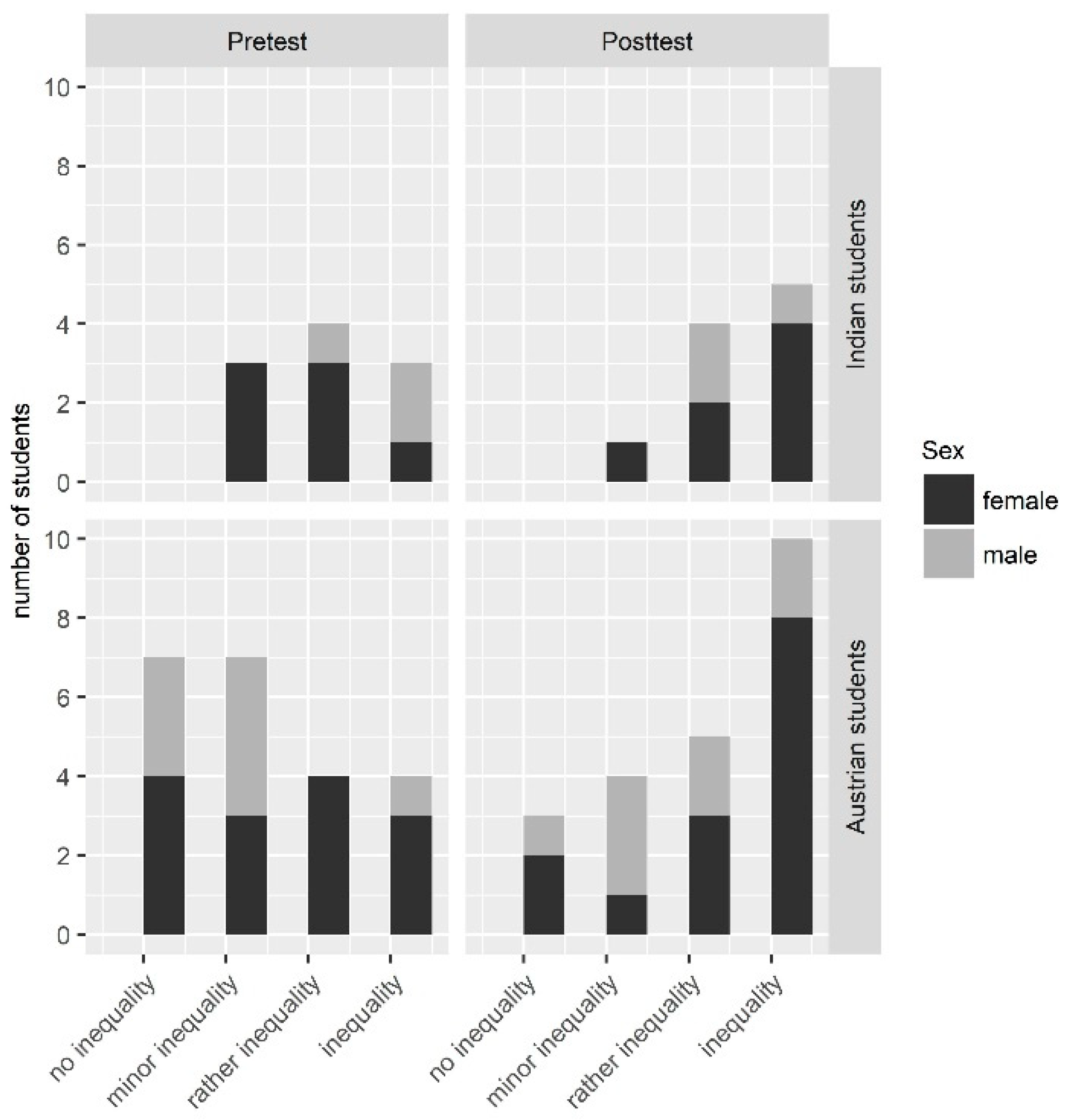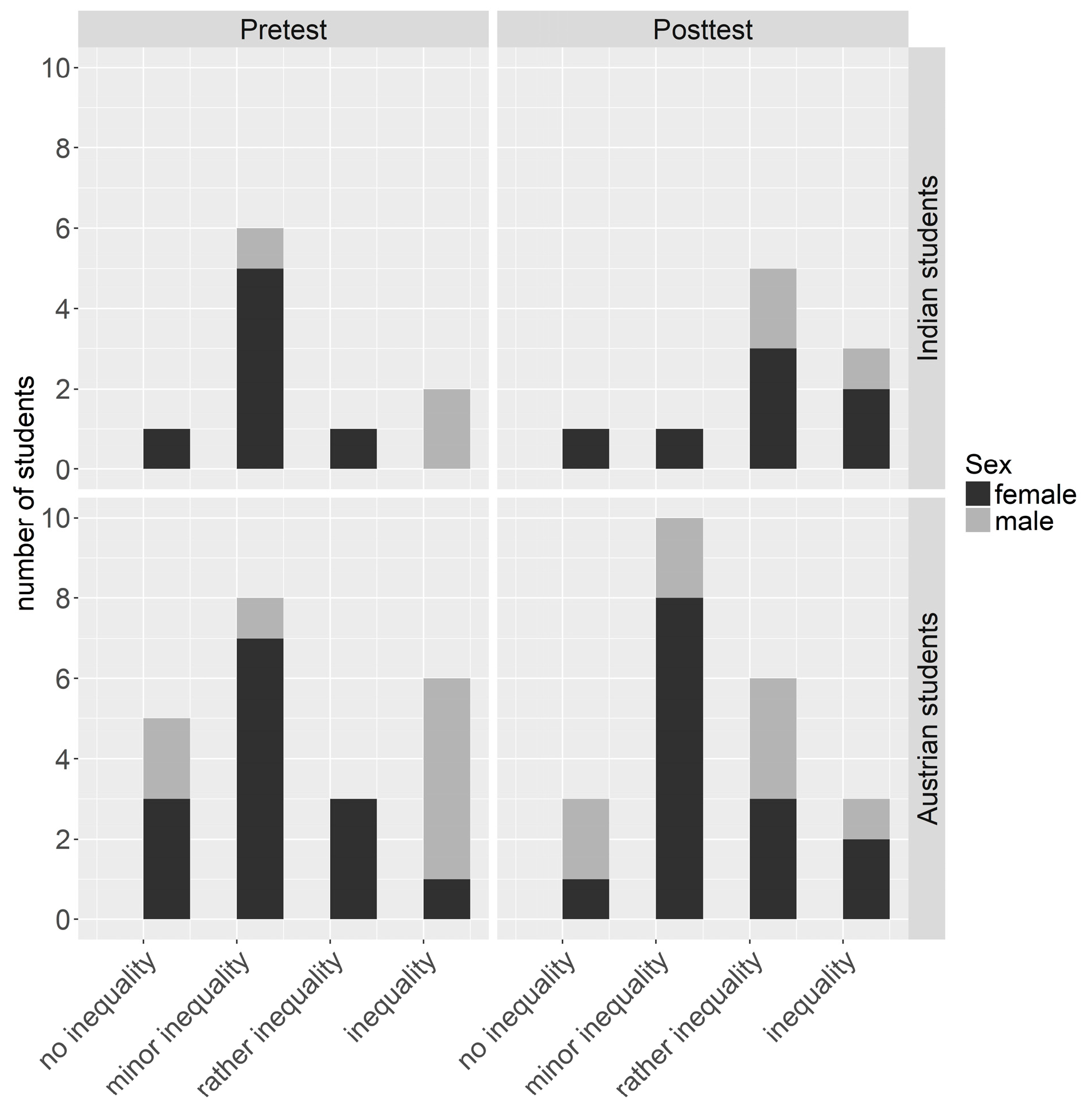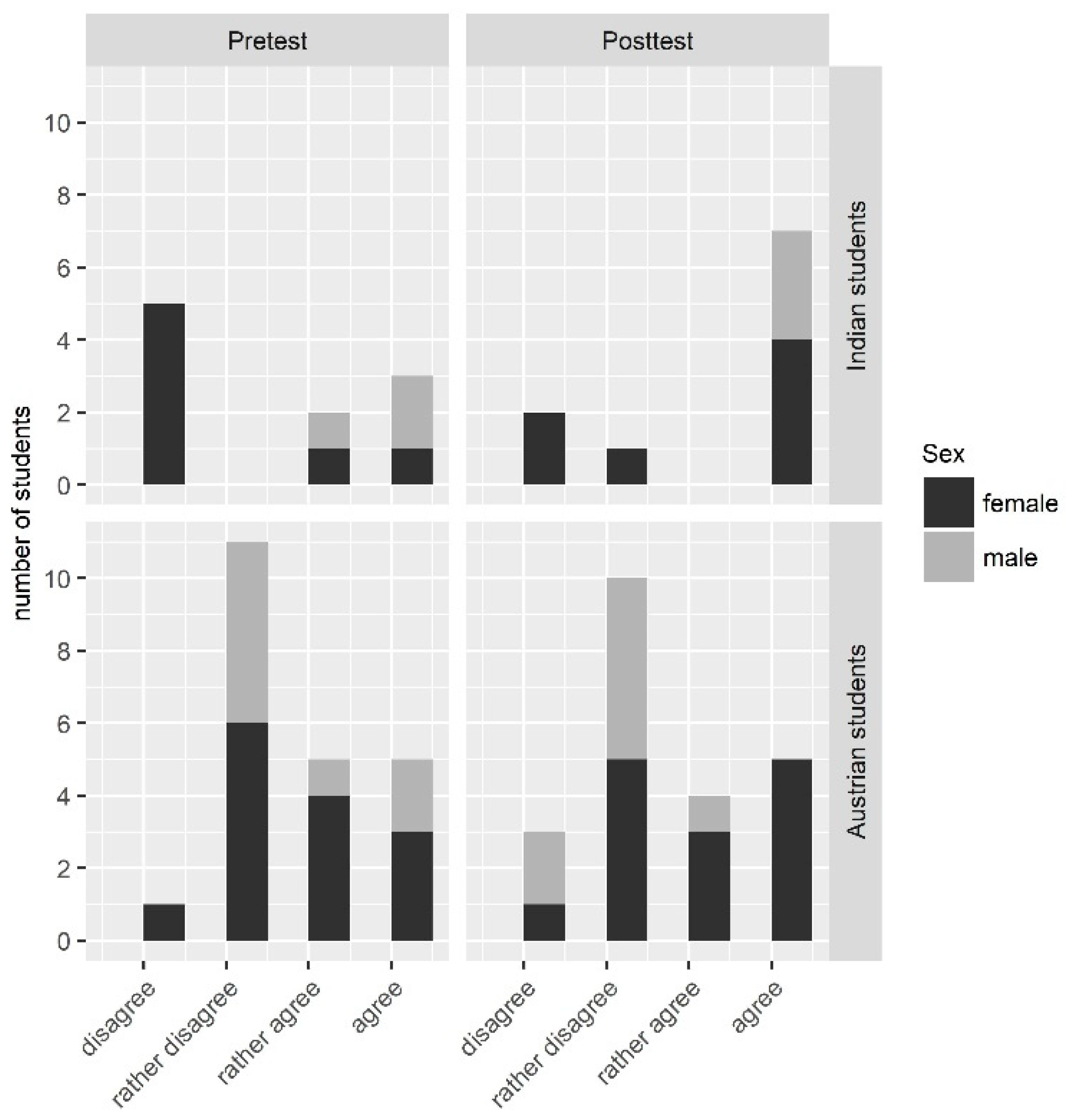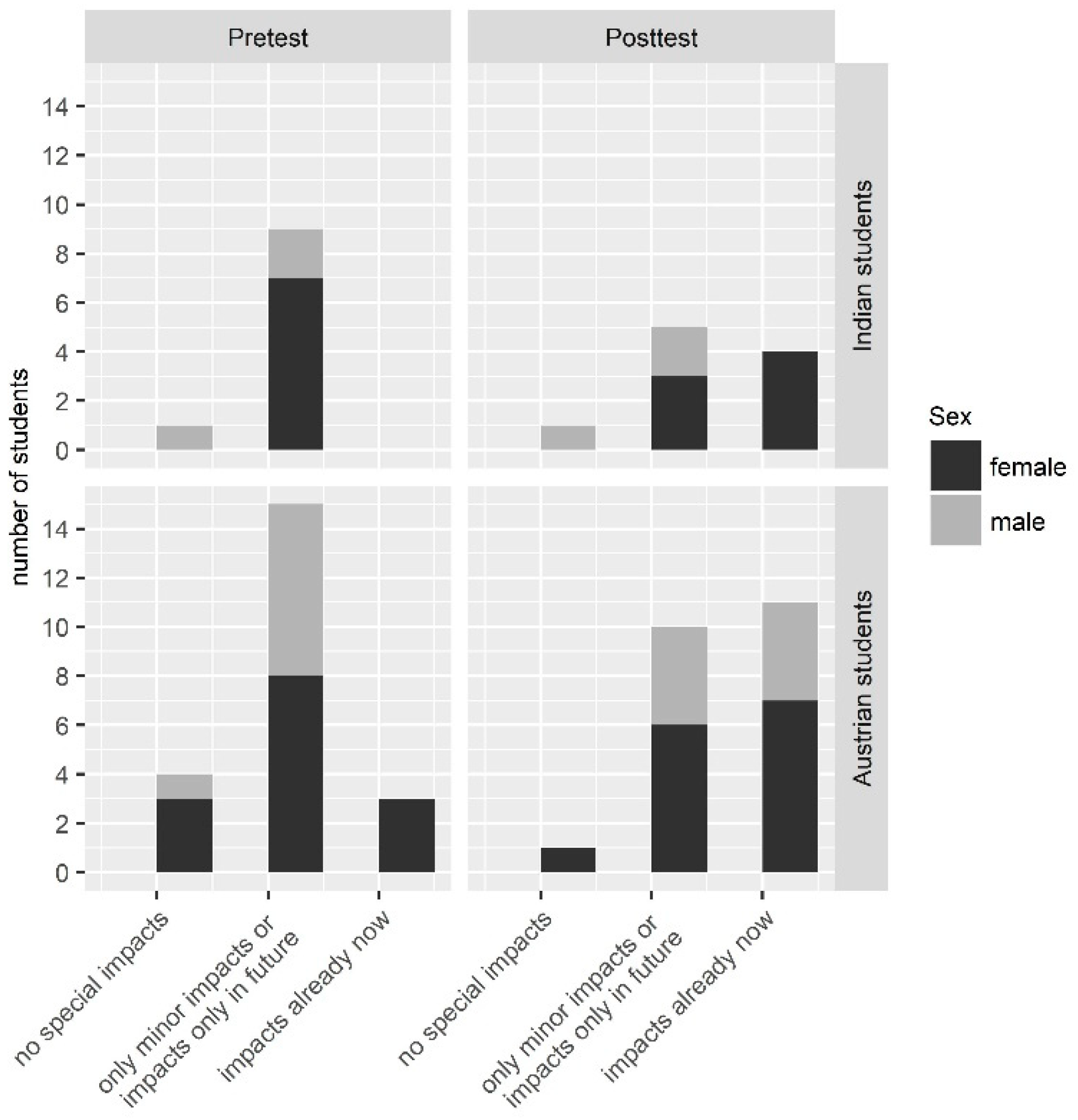Education for Sustainable Development through International Collaboration. A Case Study on Concepts and Conceptual Change of School‐Students from India and Austria on Gender Equality and Sustainable Growth
Abstract
1. Introduction
2. Conceptual Change through International Collaboration
- raises the students’ awareness that the topics gender equality and the apparent tension between the economy and the environment influence their personal quality of life and
- leads to a change in the valuation of matters connected with these two topics.
3. Methods
3.1. Project Implementation and Study Samples
3.2. Data Collection and Analysis
4. Results and Discussion
4.1. Students’ Concepts of Gender Inequality
- A)
- What personal experiences have you had within your family, your circle of friends and in your personal environment regarding issues of gender inequality?
- B)
- How do you evaluate the situation in your own country in general regarding issues of gender inequality?
- (A)
- What personal experiences have you had within your family, your circle of friends and in your personal environment regarding issues of gender inequality?
- (B)
- How do you evaluate the situation in your own country in general regarding issues of gender inequality?
‘There are some boys who believe they have a greater value and I can often hear comments like “women should stay in the kitchen” and “girls are not capable of anything”’ (AT12f). ‘The discrimination I felt was about going out to roam around. Boys are always allowed to roam around but girls cannot go out after 6’.(IN01f)
‘But as development is taking place, our society is more exposed to equality of gender’ (IN10m). ‘It is difficult to determine specific differences between men and women in everyday life because equality has reached an advanced stage in Austria already’.(AT19m)
‘Women still earn less compared to men and have less chances to get a promotion because it has always to be worried that they drop out due to pregnancy’ (AT03f). ‘Can I be a mother and a respected architect in future?’.(AT14f)
‘And one big thing is still surviving in our place. That is the dowry system. The bride’s family is demanded huge amounts to be given to the bridegroom’s family. So, people expect only male children to be born in their families. People think it is a burden to have a girl child. They also think it is due to their sin they have a girl child in their families. Therefore, abortion is done in some cases’.(IN02f)
4.2. Changes in the Students’ Concepts of Gender Inequality
‘Here my hostess is the one who every day goes out for her hobbies like singing, dancing and acting but we in our place are not allowed to go out in the night for something, generally it is not safe’.(IN04f)
‘Even if Austria comes off badly in statistics in an international comparison my subjective feeling is that the situation is better when compared with India. A lot of jobs can be done by women here which would be unimaginable in India’.(AT19m)
‘My personal experience regarding gender equality as well as my ideas about my future plans didn’t change. Nevertheless, I got a different perspective of this topic, inter-alia because of the intensive involvement during writing my work. Therefore, I became aware of many fields in which women are treated with discrimination, such as payment for a job or performing additional work in the home’.(AT22f)
‘The exchange with the Indian students gave me a lot of additional information which changed my point of view. […] I was not aware that also in small villages / towns in India there are many people who change their mind and try to provide the same education and career opportunities for their daughters’.(AT15f)
‘In Austria, we can find woman conductors, waitresses, cashiers (IN05f). I saw some women driving the bus but in India no woman drives a bus because they are not allowed to do so. It is considered as shame’.(IN08f)
4.3. Students’ Concepts of the Relationship Between Economy and Environment
- A)
- In his speech alongside the climate conference in Paris 2015 the Indian Prime Minister Modi stressed that the poor countries cannot be blamed for the actual climate change and their pursuit of economic development must not be neglected [55]. How do you personally evaluate this statement?
- B)
- Are there environmental problems due to economic development which have a direct negative impact on your personal life? If yes, specify the impact!
- C)
- If there are negative impacts: Are there personal possibilities to act in order to reduce negative impacts on the environment?
‘I don’t agree with the Prime Minister of India because I think that India is also one of the countries which is polluting our environment. We should not blame other countries. Compared to India other countries are clean’.(IN03f)
‘I cannot say if my generation will directly perceive the impacts of environmental problems—I don’t hope’ (AT03f). ‘Manali is not so much industrialized. Therefore, one can’t see a direct impact due to climate change or other problems now’.(IN07f)
‘My family for example renounces on plastic as far as possible, even plastic waste is not stored in plastic bags. Also, the car is only taken if really needed and if there is no public bus going in the right direction on time’ (AT20m). ‘First of all, we should personally segregate our waste from house into wet and dry waste, then it would be easy to treat our waste. As an individual, our responsibilities are to not litter around’.(IN07f)
4.4. Changes in the Students’ Concepts of the Relationship Between Economy and Environment
‘I as the individual agree with the Prime Minister of India because developed countries are creating more emissions and the western countries laid the development of industries and also used most of the resources. Now it is difficult for the developing countries which are dependent on the industries and they are much dominated by the countries in the west. We need to promote global justice for developing countries so that they do not match with the other countries and it will help in making the world a better place’ (IN09m). ‘The first world countries are also responsible for the climate change of the whole world due to their large carbon footprint. And the developing countries are dominated by the climate change’.(IN01f)
‘I think that people in the west have a higher standard of living and they need to rethink and change their lifestyle so that they look after quality of life and not higher standard of living. It will connect to the eastern countries too as it will become easier for them to develop and not to think about the carbon concentration. I think it’s always the people who need to be blamed, every single one of us but it’s more impacted by the western countries as they have more demand and higher standard of living. They want facilities though they don’t use them’.(IN10m)
‘Together with the Indian students we had a debate about the topic economy–environment. In this context they brought up the bad living conditions they face during winter time and that they sometimes have no electricity for several days’.(AT22f)
‘After intensive discussions with my guest from India I became aware of the exploitation of developing countries, inter alia India, through Western powers to a higher extent and I could better understand the situation of India. The Western nations gained an economic advantage by polluting the earth, which had a global impact. Nevertheless, I still hold the opinion that a complex issue like this cannot be dealt with according to the principle of ‘an eye for an eye, a tooth for a tooth,’ because this will cause global harm and at the end of the day we are all in the same boat’ (AT04m). ‘Reportedly, India is planning to double the mining and heating of coal in order to make electricity accessible for the whole population by the year 2019. Considering […] the actual climate situation, this plan of the Indian government must not be approved of at all’.(AT11m)
‘For me the statement of the Prime Minister seems arbitrary. It sounds as the Prime Minister thinks that India would have the right to produce the same amount of greenhouse gases as other nations did in the past’ (AT19m). ‘The development in the western world caused current problems wherefore one can understand Modi’s statement. But the Indian Prime Minister cannot simply state that India is not responsible as well. Due to the rapid economic development, developing and emerging countries share an increasing responsibility. Additionally, all people on the planet will feel the consequences of environmental destruction. Therefore, nations like India with their high population have to be aware of their responsibility’.(AT15f)
‘If temperature raises global ‘only’ two degrees, this can already have a massive impact on our whole life. Some skiing resorts already currently experience the consequences of global warming’ (AT20m). ‘Even by walking along a beach on holidays and the beach is polluted with plastic and other trash one recognizes the impact of the pollution of the seas’ (AT03f). ‘A huge amount of waste is already in the rivers and into the sea and is polluting drinking water and fishes. Yes, some people have lower standard of living because of this even nowadays’.(IN01f)
5. Conclusions
Supplementary Materials
Author Contributions
Funding
Acknowledgments
Conflicts of Interest
References
- United Nations Education, Scientific and Culture Organization. Education for Sustainable Development Goals Learning Objectives. 2017. Available online: http://unesdoc.unesco.org/images/0024/002474/247444e.pdf (accessed on 31 August 2018).
- United Nations Education, Scientific and Culture Organization. 2014. Available online: http://unesdoc.unesco.org/images/0023/002305/230514e.pdf (accessed on 30 August 2018).
- Gustafsson, B.; Warner, M. Participatory learning and deliberative discussion within education for sustainable development. In Values and Democracy in Education for Sustainable Development: Contributions from Swedish Research; Öhman, J., Ed.; Liber: Malmö, Sweden, 2008; pp. 75–92. [Google Scholar]
- Cörvers, R.; Wiek, A.; de Kraker, J.; Lang, D.J.; Martens, P. Problem-Based and Project Learning for Sustainable Development. In Sustainability Science—An Introduction; Heinrichs, H., Martens, P., Michelsen, G., Wiek, A., Eds.; Springer: Dordrecht, The Netherlands, 2016; pp. 349–358. [Google Scholar]
- Spitzberg, B.H.; Changnon, G. Conceptualizing intercultural competence. In The SAGE Handbook of Intercultural Competence; Deardorf, D.K., Ed.; Sage: Los Angeles, LA, USA, 2009; pp. 2–52. [Google Scholar]
- United Nations. 2016. Available online: http://www.un.org/sustainabledevelopment/sustainable-development-goals/ (accessed on 6 July 2018).
- Lundholm, C.; Davies, P. Conceptual change in the social sciences. In International Handbook of Research on Conceptual Change; Vosniadou, S., Ed.; Routledge: London, UK, 2013; pp. 288–304. [Google Scholar]
- Miyake, N. Conceptual Change through Collaboration. In International Handbook of Research on Conceptual Change; Vosniadou, S., Ed.; Educational Psychology Handbook Series; Routledge: New York, NY, USA, 2013; Volume 2, pp. 466–483. [Google Scholar]
- Saito, M.; Miyake, N. Conceptual Change through Socially Constructive Interaction in the Classroom. Proc. Annu. Meet. Cogn. Sci. Soc. 2012, 34, 2258–2263. [Google Scholar]
- Schwartz, D.L. The Emergence of Abstract Representations in Dyad Problem Solving. J. Learn. Sci. 1995, 4, 321–354. [Google Scholar] [CrossRef]
- Treagust, D.F.; Duit, R. Conceptual change: A discussion of theoretical, methodological and practical challenges for science education. Cult. Stud. Sci. Educ. 2008. [Google Scholar] [CrossRef]
- Wals, A.E.J.; Heymann, F. Learning on the Edge. Exploring the Change Potential of Conflict in Social Learning for Sustainable Living. In Educating for a Culture of Social and Ecological Peace; Wenden, A.L., Ed.; State University of New York: New York, NY, USA, 2004; pp. 123–144. [Google Scholar]
- Andreotti, V.d.O. (Towards) decoloniality and diversality in global citizenship education. Glob. Soc. Educ. 2011. [Google Scholar] [CrossRef]
- Bourn, D. The Theory and Practice of Global Learning. Research Paper No. 11 for the Global Learning Programme; Development Education Research Centre: London, UK, 2014; ISBN 978-0-9574546-3-7. [Google Scholar]
- Brendel, N.; Aksit, F.; Aksit, S.; Schrüfer, G. Multicultural group work on field excursions to promote student teachers’ intercultural competence. J. Geogr. Higher Edu. 2016. [Google Scholar] [CrossRef]
- Cook, A. What Are the Indicators of a Successful International School Partnership? Developing an operationalized theoretical standard. Ph.D Thesis, University of London, London, UK, 2013. [Google Scholar]
- Jones, C.W. Exploring the Microfoundations of International Community: Toward a Theory of Enlightened Nationalism. Int. Stud. Q. 2014, 58, 682–705. [Google Scholar] [CrossRef]
- Höhnle, S. Online-Gestützte Projekte im Kontext Globalen Lernens im Geographieunterricht: Empirische Rekonstruktion Internationaler Schülerperspektiven; Geographiedidaktische Forschungen; Hgd-Hochschulverband für Geographiedidaktik: Münster, Germany, 2014; ISBN 978-3-95645-137-9. [Google Scholar]
- Martin, F.; Griffiths, H. Power and representation: A postcolonial reading of global partnerships and teacher development through North–South study visits. Brit. Educ. Res. J. 2012. [Google Scholar] [CrossRef]
- Disney, A.C. The Contribution of International School Linking Partnerships to the Provision of Global Education. Ph.D Thesis, Nottingham Trent University, England, UK, 2008. [Google Scholar]
- Scott, P.; Asoko, H.; Leach, J. Student conceptions and conceptual learning in science. In Handbook of Research on Science Education; Abell, S., Lederman, N.G., Eds.; Lawrence Erlbaum Associates: New Jersey, NJ, USA, 2007. [Google Scholar]
- Sinatra, G.M.; Pintrich, P.R. The Role of Intentions in Conceptual Change Learning. In Intentional Conceptual Change; Sinatra, G.M., Pintrich, P.R., Eds.; L. Erlbaum: New Jersey, NJ, USA, 2003; pp. 1–18. ISBN 978-0-8058-3825-1. [Google Scholar]
- Duit, R.; Treagust, D.F. Conceptual change: A powerful framework for improving science teaching and learning. Int. J. Sci. Educ. 2003, 25, 671–688. [Google Scholar] [CrossRef]
- Reinfried, S. Lernen als Vorstellungsänderung: Aspekte der Vorstellungsforschung mit Bezügen zur Geographiedidaktik. In Schülervorstellungen und geographisches Lernen. Aktuelle Conceptual Change Forschung und Stand der Theoretischen Diskussion; Reinfried, S., Ed.; Logos: Berlin, Germany, 2010; pp. 1–31. [Google Scholar]
- Loughland, T.; Reid, A.; Petocz, P. Young People’s Conceptions of Environment: A phenomenographic analysis. Environ. Educ. Res. 2002. [Google Scholar] [CrossRef]
- Shepardson, D.P.; Wee, B.; Priddy, M.; Harbor, J. Students’ mental models of the environment. J. Res. Sci. Teach. 2007. [Google Scholar] [CrossRef]
- Walshe, N. Understanding students’ conceptions of sustainability. Environ. Educ. Res. 2008. [Google Scholar] [CrossRef]
- Assadourian, E. EarthEd: Rethinking Education on a Changing Planet; Assadourian, E., Mastny, L., Eds.; State of the World; Island Press: Washington, DC, USA, 2017; ISBN 978-1-61091-842-8. [Google Scholar]
- United Nations Education, Scientific and Culture Organization. UNESCO Global Action Programme on Education for Sustainable development 2018. Available online: http://unesdoc.unesco.org/images/0024/002462/246270e.pdf (accessed on 31 August 2018).
- Sterling, S.R. Sustainable Education: Re-Visioning Learning and Change; Schumacher Briefings; Green Books for the Schumacher Society: Totnes, UK, 2001; ISBN 978-1-870098-99-1. [Google Scholar]
- Singer-Brodowski, M. Transformatives Lernen als neue Theorie-Perspektive in der BNE. In Im Wandel—Jahrbuch Bildung für Nachhaltige Entwicklung; Umweltdachverband GmbH, Ed.; Forum Umweltbildung im Umweltdachverband: Wien, Austria, 2016; pp. 130–139. [Google Scholar]
- Taylor, E.W. An update of transformative learning theory: A critical review of the empirical research (1999–2005). Int. J. Lifelong Educ. 2007. [Google Scholar] [CrossRef]
- Pavlova, M. Education for Sustainable Development and the Transformation of Self: How the World Can Become a Better Place to Live for All. In Transfer, Transitions and Transformations of Learning; Middleton, H.E., Baartman, L.K.J., Eds.; Sense Publishers: Rotterdam, The Netherlands, 2013; Volume 11, pp. 123–132. [Google Scholar]
- Sterling, S. Learning for resilience, or the resilient learner? Towards a necessary reconciliation in a paradigm of sustainable education. Environ. Educ. Res. 2010. [Google Scholar] [CrossRef]
- Hodson, D.; Hodson, J. From constructivism to social constructivism: A Vygotskian perspective on teaching and learning. Sch. Sci. Rev. 1998, 79, 33–41. [Google Scholar]
- Collins, A.; Brown, J.S.; Newman, S.E. Cognitive Apprenticeship: Teaching the Craft of Reading, Writing and Mathematics. Think. J. Philos. Child. 1988. [Google Scholar] [CrossRef]
- Schuler, S. Wie entstehen Schülervorstellungen? Erklärungsansätze und didaktische Konsequenzen am Beispiel des globalen Klimawandels. In Schülervorstellungen und Geographisches Lernen. Aktuelle Conceptual Change Forschung und Stand der Theoretischen Diskussion; Reinfried, S., Ed.; Logos: Berlin, Germany, 2010; pp. 157–188. [Google Scholar]
- Vosniadou, S. Conceptual Change in Learning and Instruction. The Framework Theory Approach. In International Handbook of Research on Conceptual Change; Vosniadou, S., Ed.; Routledge: New York, NY, USA, 2013; pp. 11–30. [Google Scholar]
- Edge, K.; Frayman, K.; Lawrie, J. The Influence of North South School Partnerships: Examining the Evidence from Schools in the United Kingdom, Africa and Asia; Institute of Education: London, UK, 2009. [Google Scholar]
- Kahn, H.E.; Agnew, M. Global Learning Through Difference: Considerations for Teaching, Learning, and the Internationalization of Higher Education. J. Stud. Int. Educ. 2017. [Google Scholar] [CrossRef]
- Asbrand, B. Wissen und Handeln in der Weltgesellschaft: Eine Qualitativ-Rekonstruktive Studie zum Globalen Lernen in der Schule und in der außerschulischen Jugendarbeit; Erziehungswissenschaft und Weltgesellschaft; Waxmann: Münster, Germany, 2009; ISBN 978-3-8309-2120-2. [Google Scholar]
- Scridon, A. Nachhaltigkeit macht Schule! Empfehlungen für Erfolgreiche und Qualitative Schulpartnerschaften Weltweit; Interkulturelles Zentrum: Wien, Austria, 2014. [Google Scholar]
- Day Star School. Available online: http://www.daystarmanali.org/ (accessed on 20 September 2018).
- Gymnasium Schillerstraße. Available online: https://gys.at (accessed on 20 September 2018).
- Bildung in Zahlen. Available online: https://uniko.ac.at/modules/download.php?key=13584_DE_O&cs=4BAE (accessed on 26 October 2018).
- Census of India. Available online: http://www.censusindia.gov.in/pca/default.aspx (accessed on 5 June 2017).
- Meyer, C. Moralisches Dilemma /Dilemmadiskussion. In Geographie Unterrichten Lernen. Die Didaktik der Geographie; Reinfried, S., Haubrich, H., Eds.; Cornelsen: Berlin, Germany, 2015; p. 170. [Google Scholar]
- Fridrich, C. Kompetenzorientiertes Lernen mit Mysterys—Didaktisches Potenzial und methodische Umsetzung eines ergebnisoffenen Lernarrangements. GW-Unterricht 2015, 140, 50–62. [Google Scholar]
- Mayring, P. Qualitative Inhaltsanalyse: Grundlagen und Techniken; 12.; Beltz: Weinheim, Germany, 2015; ISBN 978-3-407-25730-7. [Google Scholar]
- Kuckartz, U. Qualitative Inhaltsanalyse: Methoden, Praxis, Computerunterstützung, Grundlagentexte Methoden, 2nd ed.; Beltz Juventa: Weinheim, Germany, 2014; ISBN 978-3-7799-2922-2. [Google Scholar]
- Tinklin, T.; Croxford, L.; Ducklin, A.; Frame, B. Gender and attitudes to work and family roles: The views of young people at the millennium. Gend. Educ. 2005. [Google Scholar] [CrossRef]
- The United Nations Development Programme. Available online: http://hdr.undp.org/sites/default/files/2016_human_development_report.pdf (accessed on 1 September 2018).
- Morrison, Z.; Bourke, M.; Kelley, C. ‘Stop making it such a big issue’: Perceptions and experiences of gender inequality by undergraduates at a British University. Women Stud. Int. Forum 2005. [Google Scholar] [CrossRef]
- Wrigley, B.J. Glass Ceiling? What Glass Ceiling? A Qualitative Study of How Women View the Glass Ceiling in Public Relations and Communications Management. J. Public Relat. Res. 2002. [Google Scholar] [CrossRef]
- Narendra Modi. Available online: http://www.narendramodi.in/pm-modi-addresses-the-plenary-session-at-cop-21-summit-in-paris-385298 (accessed on 3 September 2018).
- Dür, M. Lebensqualitätsvorstellungen als Basis einer Zusammenarbeit indischer und österreichischer Jugendlicher. Erste Ergebnisse eines Forschungsprojekts im Rahmen von Bildung für Nachhaltige Entwicklung. GW-Unterricht 2016, 1, 80–90. [Google Scholar] [CrossRef]
- Kuckartz, U.; Rheingans-Heintze, A. Trends im Umweltbewusstsein: Umweltgerechtigkeit, Lebensqualität und Persönliches Engagement; Umweltbundesamt, Ed.; 1. Aufl.; VS, Verl. für Sozialwiss: Wiesbaden, Germany, 2006; ISBN 978-3-531-90196-1. [Google Scholar]
- Oberrauch, A.; Keller, L. Vorstellungen von Jugendlichen zur Lebensqualität zwischen Materialismus und Umweltorientierung. Eine empirische Untersuchung im Kontext (einer Bildung für) nachhaltige(r) Entwicklung. Zeitschrift für Geographiedidaktik (ZGD) 2017, 45, 3–32. [Google Scholar]
- Sternäng, L.; Lundholm, C. Climate change and costs: Investigating students’ reasoning on nature and economic development. Environ. Educ. Res. 2012. [Google Scholar] [CrossRef]
- Rieckmann, M. Future-oriented higher education: Which key competencies should be fostered through university teaching and learning? Futures 2012. [Google Scholar] [CrossRef]
- Lidgren, A.; Rodhe, H.; Huisingh, D. A systemic approach to incorporate sustainability into university courses and curricula. J. Clean. Prod. 2006. [Google Scholar] [CrossRef]
- Skamp, K.; Boyes, E.; Stannistreet, M. Global warming responses at the primary secondary interface: 1. Students’ beliefs and willingness to act. Aust. J. Environ. Educ. 2009, 25, 15–30. [Google Scholar] [CrossRef]
- Chhokar, K.; Dua, S.; Taylor, N.; Boyes, E.; Stanisstreet, M. Senior Secondary Indian Students’ Views about Global Warming, and Their Implications for Education. Sci. Educ. Int. 2012, 23, 133–149. [Google Scholar]
- Corner, A.; Roberts, O.; Chiari, S.; Völler, S.; Mayrhuber, E.S.; Mandl, S.; Monson, K. How do young people engage with climate change? The role of knowledge, values, message framing, and trusted communicators: Engaging young people with climate change. Wiley Interdiscip. Rev. Clim. Chang. 2015. [Google Scholar] [CrossRef]




© 2018 by the authors. Licensee MDPI, Basel, Switzerland. This article is an open access article distributed under the terms and conditions of the Creative Commons Attribution (CC BY) license (http://creativecommons.org/licenses/by/4.0/).
Share and Cite
Dür, M.; Keller, L. Education for Sustainable Development through International Collaboration. A Case Study on Concepts and Conceptual Change of School‐Students from India and Austria on Gender Equality and Sustainable Growth. Educ. Sci. 2018, 8, 187. https://doi.org/10.3390/educsci8040187
Dür M, Keller L. Education for Sustainable Development through International Collaboration. A Case Study on Concepts and Conceptual Change of School‐Students from India and Austria on Gender Equality and Sustainable Growth. Education Sciences. 2018; 8(4):187. https://doi.org/10.3390/educsci8040187
Chicago/Turabian StyleDür, Martin, and Lars Keller. 2018. "Education for Sustainable Development through International Collaboration. A Case Study on Concepts and Conceptual Change of School‐Students from India and Austria on Gender Equality and Sustainable Growth" Education Sciences 8, no. 4: 187. https://doi.org/10.3390/educsci8040187
APA StyleDür, M., & Keller, L. (2018). Education for Sustainable Development through International Collaboration. A Case Study on Concepts and Conceptual Change of School‐Students from India and Austria on Gender Equality and Sustainable Growth. Education Sciences, 8(4), 187. https://doi.org/10.3390/educsci8040187




